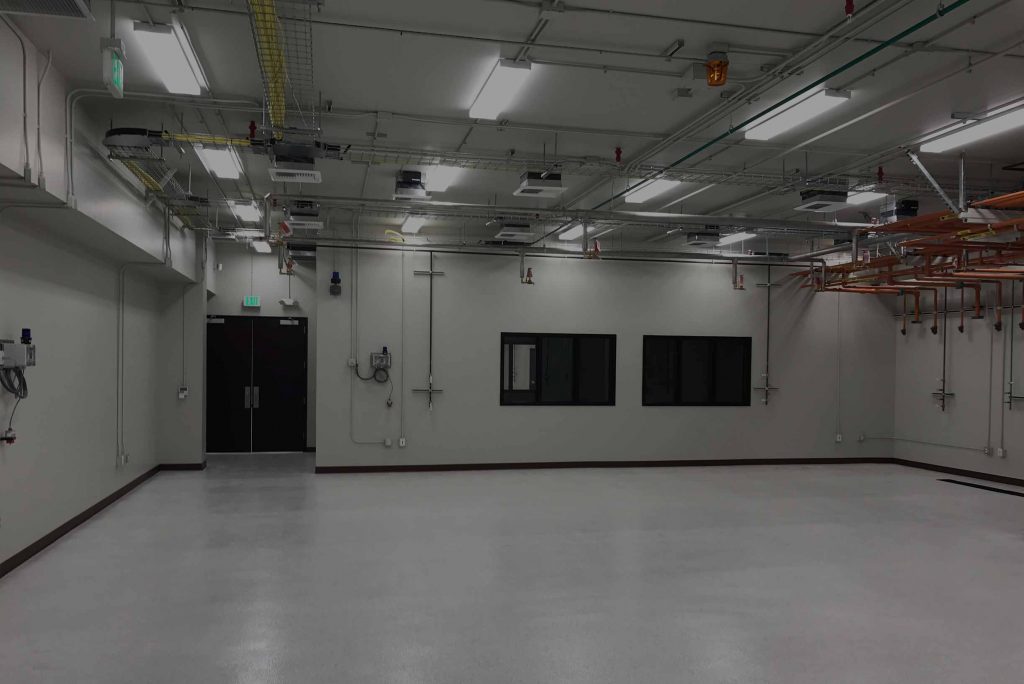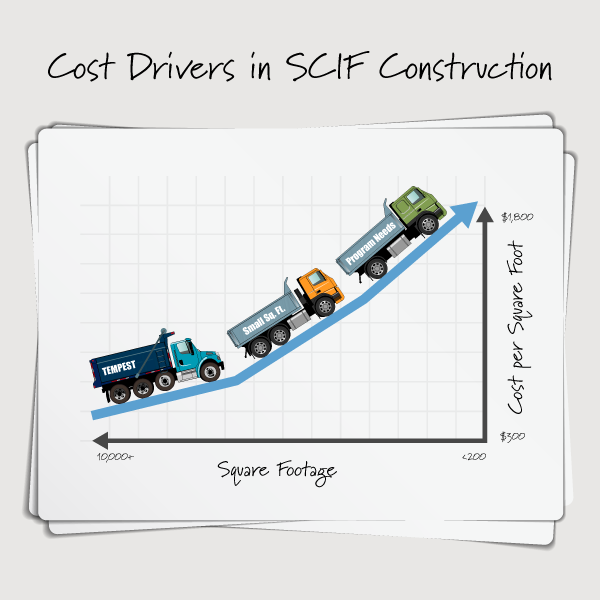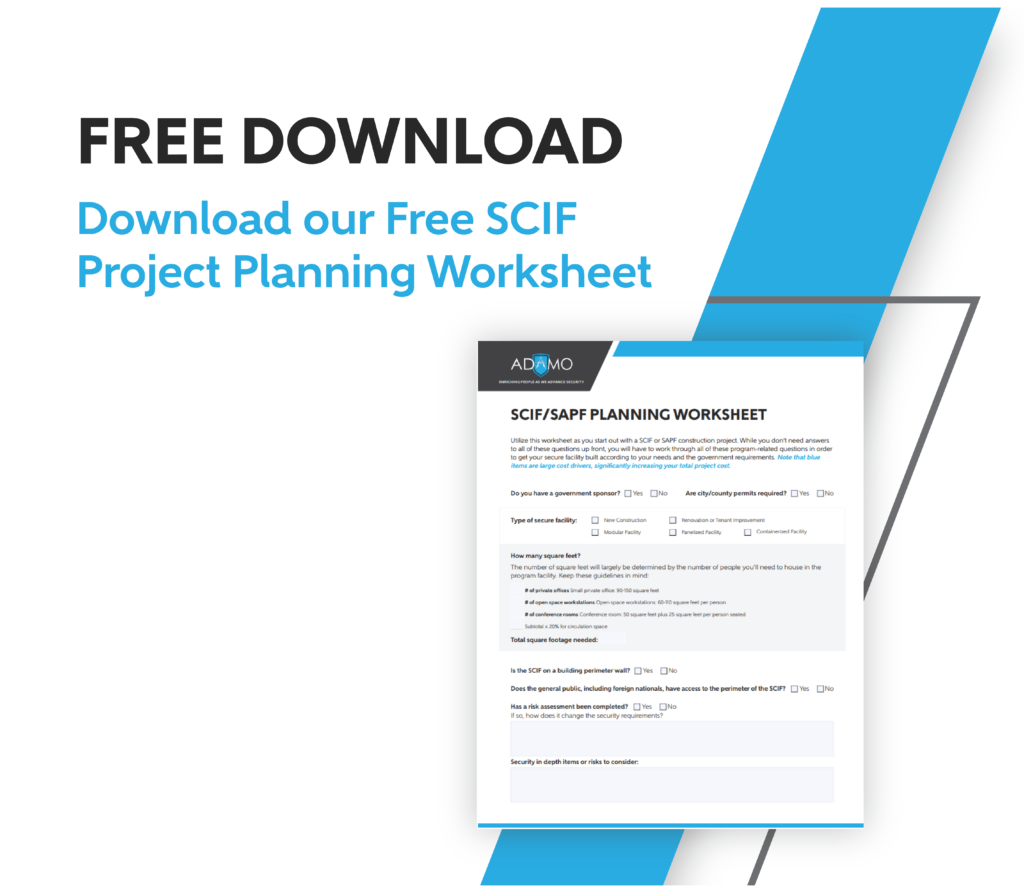The top factors and applications that increase the price of building a SCIF
There’s a lot more to building a Sensitive Compartmented Information Facility (SCIF, pronounced “skiff”) than you might think—at the very least, it requires physical security, acoustic protections, visual controls, mechanical/electrical/plumbing (MEP) systems, electronic access control systems (ACS), intrusion detection systems (IDS) and TEMPEST mitigations. When it comes to building such a facility, the cost range is wide.
Cost Drivers
One of the biggest factors that drives price is the type of construction—you’ll need to determine which approach for your SCIF best meets the program’s needs. Options include conventional ground-up construction, tenant improvement (or T.I., renovating an existing building) or modular construction, which comes in three different forms—roll-on (mobile-home-style, but better built), panelized and container (Conex box or customer built).
Other factors that can significantly increase the cost are whether you can use a U.S. citizens or U.S. persons workforce, and what TEMPEST mitigations your project requires. The current standards have restrictions to project workers (such as U.S. citizenship), which limit the pool of workers, impacting the price and schedule. In addition, if your project requires TEMPEST mitigations (essentially a way to protect the compromising emanations/signals coming off of your equipment from getting intercepted), as recommended by the Certified TEMPEST Technical Authority (C.T.T.A.), this can have significant cost and schedule impact on your SCIF project.
Related: How to Build a SCIF Right – The First Time

You’ll also need to keep in mind that because of the unique construction features of a SCIF, scaling down your square footage doesn’t mean the price per square foot will drop as quickly. For example, if you cut your 600-square-foot SCIF down to 300 square feet, the price won’t also drop by 50 percent. That’s because every SCIF project has a number of what could be called “fixed costs,” including project management, oversight, design, an intrusion detection system, an access control system, and a sound-rated perimeter door with high-security hardware. Whether your facility is 10 square feet or 20,000, you’ll need all of those items in order to achieve government accreditation.
Following the pandemic, material shortages both significantly drove up prices and caused significant delays in construction. Materials like steel studs, drywall and plywood increased in cost by more than 30% and lumber as much as doubled in cost between 2019 and 2022. Between these shortages and inflation, prices increased significantly.
In 2024, material shortages have been largely resolved, leading to a slight drop in the price for materials and therefore the overall SCIF cost, and prices have returned closer to what they were pre-pandemic.
To give you an idea of the potential cost of a SCIF, if you’re building a SCIF less than 200 square feet, we would recommend budgeting a minimum of $900 per square foot (we’ve seen as high as $1,800). During the material shortages, we were recommending $1,500 as the minimum, so this is a significant decrease. At the other end of the spectrum, if you’re building, say, 8,000 square feet, you can potentially expect the cost to fall below $300 per square foot. This is down from the $400 we were seeing during the shortages. These numbers can be impacted by whether or not you are able to utilize existing MEP systems, as well as other program-driven needs, such as backup power requirements or redundant MEP systems.

When comparing the cost per square foot, in most cases, standard T.I. construction will be the most cost-effective, provided that you’re not dealing with structural upgrades, asbestos abatement or any other extenuating circumstances. We typically see these spaces costing an average of $600-$750 per square foot right now. When it comes to new construction, roll-on modular is usually the least expensive, especially when adding a large amount of square footage. The third least expensive is the Conex box, though you’re constrained to a very small amount of customization. The most expensive solution, no matter the square footage, is panelized modular. Even though it’s the most expensive, it proves to be a great solution for some clients because it provides flexibility for the layout and the panels can be disassembled and relocated.
Cost Controllers
No matter which solution is the right fit for you, there is no way around the fact that SCIFs are an expensive type of construction project. However, there are a few things you can do to ensure that you’re keeping your costs under control:
- Know your program requirements. Familiarize yourself with exactly what your program needs regarding acoustic protections, physical security, data/comm, TEMPEST mitigations, etc. Don’t overbuild and drive up the price for features that aren’t actually required. For example, installing interior STC 50 walls and doors (versus STC 45) where they are not needed or required can add more than 15% to your total project cost. Requiring expanded metal where plywood hardening is sufficient will add many thousands of dollars. Assumptions can get expensive, so know what you need!
- Set realistic timeframes. Compressed schedules significantly increase your budget cost because of things such as compressed bid schedules, expedited material ordering, and paying for overtime or shift work. Allowing adequate time for planning, permitting, accrediting official (A.O.) approval, construction and final accreditation approval is critical to cost control. Due to shipping and material delays, even basic parts like light fixtures, breakers and panels can delay a project by several months. RF shielding material currently faces some of the greatest delays. Keep these increased lead times in mind when budgeting.
- Think through your SCIF placement. Placing your facility in the interior of an office building you control, as opposed to an exterior door or window, will reduce your project cost because doors, windows and incorporating exterior walls require extra security measures. In the same way, if your multi-story building does not have concrete pan decks, putting it on the ground floor can provide a large cost savings. Also, consider placing it in a location that is only accessible by U.S. Citizens.
- Engage your A.O. early. As soon as your DD-254 is issued, start the conversation with your accrediting official. The sooner they’re involved, the more of their input you can incorporate into the early stages of the design and planning, thereby reducing the need for back and forth later on, or adding security requirements later in the project cycle, when it may be more expensive.
- Hire an expert. Rework and delays are very expensive (and time-consuming). A company with years of experience in design and construction of SCIFs will not only understand the nuances of building a facility that will be accredited, but it can also foresee problems and adjust accordingly with minimal effect to your timeline and budget.
 Remember that because each company, program and situation is slightly different, each SCIF project will be slightly different. Your project could be less or more costly in terms of times, money and effort than the examples we speak to here. The best way to know what your project will costs is to build the right team of people who can understand what is needed, then move forward together. For more information on the entire SCIF process, read our SCIF construction guide.
Remember that because each company, program and situation is slightly different, each SCIF project will be slightly different. Your project could be less or more costly in terms of times, money and effort than the examples we speak to here. The best way to know what your project will costs is to build the right team of people who can understand what is needed, then move forward together. For more information on the entire SCIF process, read our SCIF construction guide.
Adamo can offer expert help and come alongside your team through every step of the construction process. Contact us today to see how we can help you manage costs and get your project to accreditation.
Editor’s note: The original version of this article was published in 2019 but has been updated in 2024 to include current pricing information.



